【By Observer Net Columnist Yu Pengkun】
On July 16 local time, U.S. President Trump announced the cancellation of federal funding for California's high-speed rail project to fulfill his commitment to cut unnecessary spending. Last month, the U.S. Department of Transportation released a harsh report accusing the project of serious delays and budget overruns, determining that it no longer met the criteria for funding.
After Trump's statement, Transportation Secretary Sean Duffy quickly acted, immediately announcing that the railway authority had terminated funding for the project, "saving" about $4 billion that had not yet been allocated.
Subsequently, Trump and Sean Duffy entered into a "mutual praise mode." Duffy stated, "Trivial and useless projects should be dead, and President Trump and I will ensure that taxpayers' money is only used for projects that create great, grand, and beautiful things." Trump then wrote, "Thank you to Transportation Secretary Sean Duffy; no more cents from federal funds will flow into new bubble scams."
On his own media platform "Social Truth," known for being bold and progressive, Trump continued to "attack" the California high-speed rail project: "The railway we were promised still does not exist and will never be built," "This project is too expensive, over-regulated, and has never been delivered."
However, within less than 24 hours, the California High-Speed Rail Authority (CHSRA) decided to sue the federal government. California Governor Gavin Newsom stated, "Canceling the funding is due to (Trump's) personal hostility toward California and the high-speed rail project, not facts," and California would use all means to "fight this illegal act."
Evidently, the opposing statements between the U.S. president and the California governor can only have one realistic conclusion.
The Inherent Advantages of California High-Speed Rail
As of 2024, the U.S. population has exceeded 340 million. A large population and a massive economy have created a thriving transportation industry. In the same year, the U.S. had over 5,000 civilian airports. According to data from Statista, the total mileage of U.S. highways reached 4.197 million statutory miles in 2022, equivalent to 6.755 million kilometers. Whether per capita, geographic density or total volume, the U.S. air and road transport have performed outstandingly.
However, the development of high-speed rail in the U.S. is very lagging. According to data from the country statistics organization "World Population Review," the U.S. high-speed rail mileage before 2025 was nominally 6,071 kilometers, which could rank second in the world. However, most of these lines are just technically upgraded, theoretically capable of running 200 km/h passenger trains, but their actual operations are still low-speed freight.
According to the International Union of Railways (UIC), the actual high-speed rail mileage in the U.S. is only 735 kilometers, ranking after ten countries including China, Spain, Japan, France, and Germany.

High-speed rail operation mileage in various countries as of mid-2024 (Source: watermark)
U.S. high-speed rail development is often attributed to conflicts between local and federal governments and partisan struggles, but California high-speed rail is an exception. There is no obvious local and party resistance, and it has unique development conditions.
California, abbreviated as California, is a "long" state located on the U.S. West Coast. California has two city centers, with the first largest city Los Angeles and the second largest city San Diego on the southern coast, while the Bay Area metropolitan area in the central and northern parts includes the third largest city San Jose and the fourth largest city San Francisco. There is significant demand for personnel between the two urban clusters. Therefore, when California's high-speed rail was proposed in 2008, all decision-making processes went smoothly.
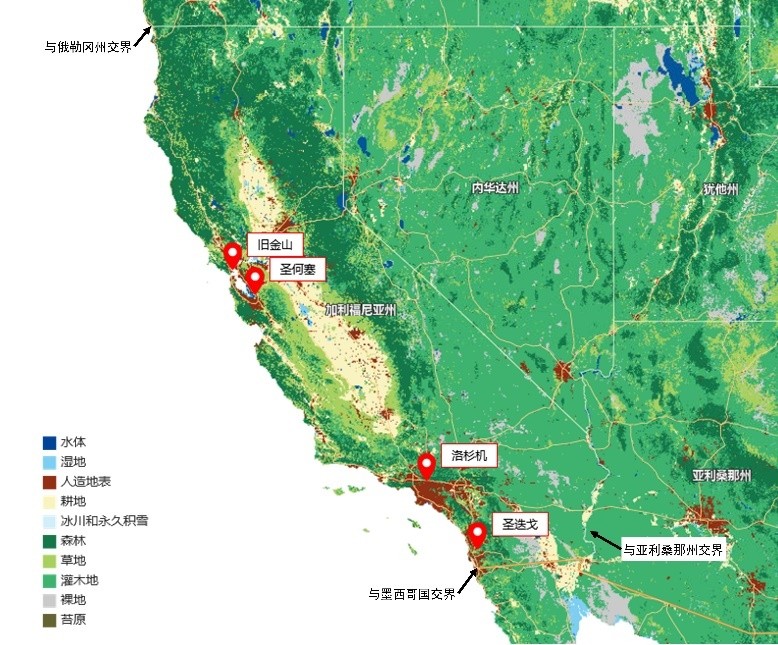
Map of California from the Chinese Ministry of Natural Resources, Tianditu
Bill No. 3034 contains two important contents: first, to incorporate the initial planning of California's high-speed rail into the local public utility code, providing legality for land acquisition and subsequent progress, requiring the determination of the route and operating time, and obtaining public authorization during the 2008 election; second, to issue bonds worth $9.95 billion to start the construction of California's high-speed rail.
Bill No. 3034 was completed as a draft on February 24, 2008, passed by the state legislature on August 13 of the same year, then quickly signed by the famous movie star and then-governor Schwarzenegger, and sent to the Secretary of State for filing on August 26, completing all legislative procedures. Regarding public awareness, it also received voter approval in the November election of the same year. From the American perspective, the launch of California's high-speed rail was smooth.
The person who initially strongly promoted the high-speed rail, Schwarzenegger, came from the Republican Party that Trump belongs to, and the current governor, Gavin Newsom, who is a Democrat and clashed directly with Trump over the high-speed rail, is a Democrat. Bill No. 3034 went through seven votes, and each vote had a significantly higher number of votes in favor than against. There was a basic consensus between the two parties on building California's high-speed rail. At the beginning, this consensus was even more solid.
Since it was not a partisan struggle, all the routes were within California, there was no coordination issues caused by cross-regional construction. At the same time, California has nearly 40 million residents, making it the most populous state in the U.S., and it has the two richest urban clusters on the West Coast, as well as federal financial subsidies. From any dimension, the California high-speed rail project has unique development conditions, and it seems impossible to fail.
Why Has It Not Been Completed After 17 Years?
Yet, after 17 years, the California high-speed rail remains unfinished. If we trace back, the seeds of failure were already sown before the project was launched.
In 1981, the California government considered collaborating with Japanese manufacturers to build the South California High-Speed Rail Corridor. Through contact with Japanese companies, the California Inter-City High-Speed Rail Commission found that building a low-standard high-speed railway seemed technically not so difficult, and it was possible to build it independently using American resources. Thus, in 1996, the California Legislature established the California High-Speed Rail Authority (CHSRA) to supervise and promote the California high-speed rail project.
By 2008, CHSRA had been in operation for 12 years and had continuously issued research reports and lobbied for high-speed rail construction. At the time, the general public in California believed that CHSRA had the professional expertise to lead the high-speed rail construction. Ironicaly, in these 12 years of operation, CHSRA did not accumulate much professional capability, and political manipulation and bureaucracy became its strength.
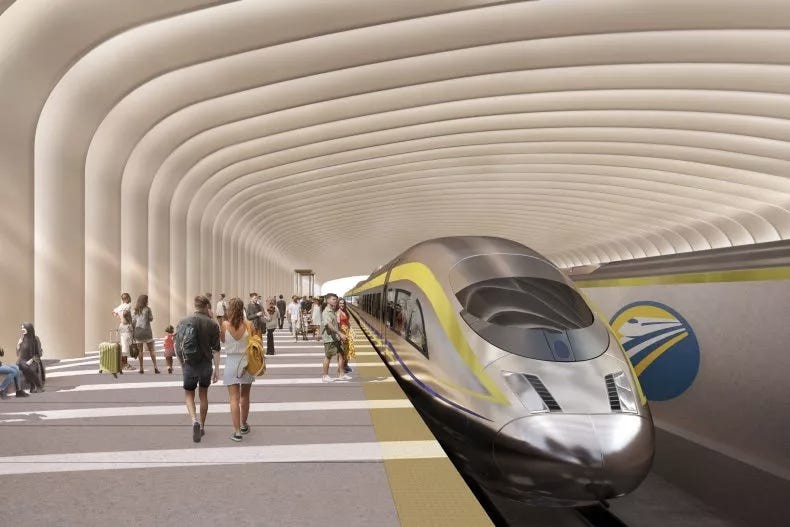
Conceptual image of California high-speed rail
When California's high-speed rail was proposed, according to the 2006 prices, the construction cost was $30 billion. Considering inflation, CHSRA believed that $33 billion in funding was needed. But CHSRA knew that American politicians and voters liked "premature consumption," so they proposed issuing bonds to build the high-speed rail. Normally, the total amount of bond issuance should be greater than $30 billion, and $35 billion or even $40 billion would be normal, so that it could cover the construction costs, rather than $9.95 billion.
CHSRA knew from the beginning that there was a huge funding gap, so they proposed phased construction to ease the pressure, which was clearly a bad idea. The experience of high-speed rail development in various countries shows that the main high-speed rail corridor should be prioritized, and then the branch lines should be gradually expanded once the conditions are mature. The main high-speed rail corridor has significant economies of scale, and the unit cost per passenger is far lower than the branch lines that are not systematized and built separately.
To make matters worse, the California high-speed rail lacked clear and professional line planning, and CHSRA completely shifted this responsibility to the voters' committee. Most citizens lack professional knowledge, but they naively hope that the high-speed rail passes through their cities. As a result, the 1,300-kilometer-long California high-speed rail system has 24 stations, almost passing through all major towns. This not only makes the California high-speed rail route not smooth and limited in speed, but also becomes the root of many later controversies.
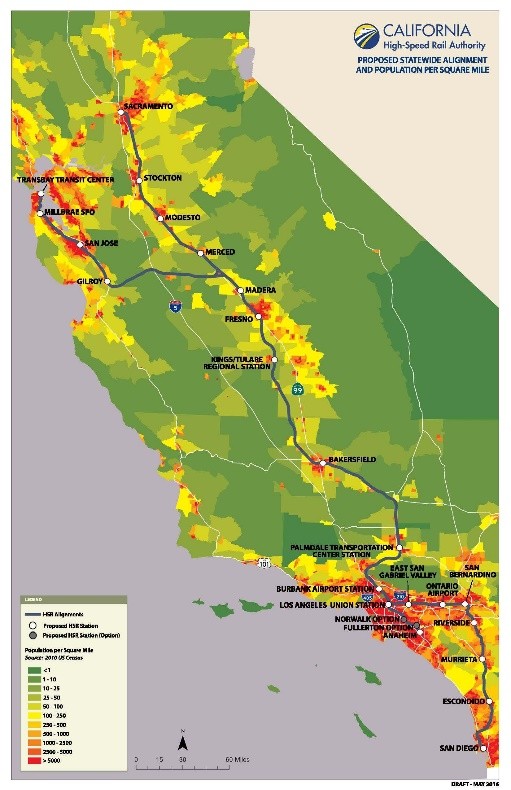
California high-speed rail plan and population density in 2016
Due to the insufficient funding of $9.95 billion to build all the lines, and the lack of clear planning, the original public support for California's high-speed rail began to diverge—everyone wanted to prioritize the sections that benefited them. American infrastructure observer ROSALES found that during this process, CHSRA could not unite the public, and even failed to provide planning and cost estimates for each section, resulting in the 2008 economic crisis having almost no impact.
From 2009 to 2015, nearly six years were wasted arguing and changing the construction plans. At the same time, the $9.95 billion also kept shrinking due to inflation and paying bond interest. It wasn't until 2015 that California's high-speed rail finally started construction in Fresno, with an initial segment of only 46.7 kilometers.
The initial stage's absurd delays and waste further undermined investor and public confidence, leading to reduced funding, which forced CHSRA to divide the California high-speed rail plan even more finely. The increase in the number of engineering segments exacerbated management difficulties, caused new delays, and triggered greater conflicts.
In 2014, the California High-Speed Rail Business Plan released by CHSRA received a lukewarm response, making it difficult to attract private capital, and it had to rely on federal government funding. Allocating funds to such a project with inherent flaws benefits the Democrats in winning over establishment figures, but is detrimental to the Republicans' efforts to manage the U.S. finances, thus California's high-speed rail has always struggled to receive sufficient and stable funding under partisan battles.
2015 to 2019 was the last opportunity window for California's high-speed rail, but unfortunately, due to a lack of skilled workers and supporting industries, the initial segment again experienced inexplicable delays.
By 2019, Trump canceled $928 million for California's high-speed rail and reclaimed some funds, reducing the total by nearly $1 billion, which negatively impacted the construction. In 2020, the global pandemic swept across the world, and the U.S. infrastructure and other areas fell into recession. Not long after recovering from the pandemic, the U.S. infrastructure sector faced rising material prices. For example, the producer price index for cold-rolled steel was more than three times that of 2020 in 2021, and it remained at a high level to this day.
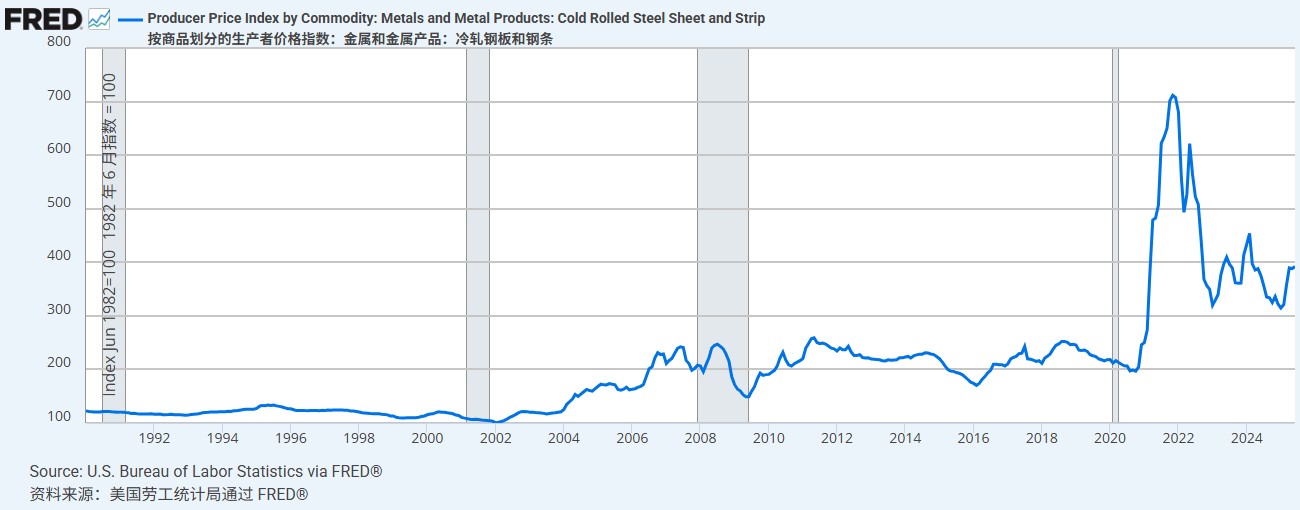
Cold-rolled steel consumer index
Delays also caused serious land disputes. According to California's local laws, when land is designated for surveying, landowners can receive a one-time compensation. However, they can only claim the remaining compensation after the construction is completed and the land use is confirmed. Obviously, the longer the time from the initial survey to the acceptance, the more disadvantageous it is for the landowners. As Texas anti-high-speed rail social activist Sitilides said: "They don't have a clear funding channel, yet they can block landowners from using and developing their private land for years."
The Republicans accuse California's high-speed rail of wasting $15.7 billion, most of which was spent waiting, and the rest, along with funding after 2015, was either used for the initial segment's construction, or for subsidies for the Bay Area urban cluster's self-built internal lines (mainly San Francisco to San Jose), and some were claimed to be used for planning, surveying, land acquisition, and environmental impact assessments for other lines.
It wasn't until February 2024 that the initial segment was "substantially completed," and it was shortened again to 36.2 km. Such a short line has no practical operational significance, and only this year another segment was completed before the tracks were laid.
Currently, California's high-speed rail is only discussed in terms of survival or summarizing lessons, and more Americans have lost hope, considering it part of long-term visions like "California railway modernization" and "American Southwest high-speed rail network."
Can the U.S. Develop High-Speed Rail?
Looking back at the disastrous path of California's high-speed rail, the unprofessional team CHSRA is hard to escape blame. But the U.S. high-speed rail construction itself also has many systemic problems.
Trump approved the Texas high-speed rail project during his first term. According to a spokesperson from the railway project development company Jent, "No other state can match Texas's health and dynamic business environment, nor can any other state better understand how to meet people's needs. The Trump administration first approved this project, but it was unfortunately stalled by Biden administration's political struggles."
This spokesperson completely blamed Biden, but deliberately avoided their own responsibilities. In fact, the Texas high-speed rail is only 386 km long. Even in Japan or Spain, using the more than three years of time before Biden halted it, it would have achieved a phase result. If it were in China, similar projects might have already been in operation.
Regarding the future of the Texas high-speed rail, spokesperson Jent was very confident: "Under the leadership of President Trump, the Texas Central High-Speed Rail is ready. This project will improve travel safety, create a large number of jobs, and drive Texas' economic growth."
I believe that if the U.S. cannot improve its systemic problems, even with Trump's strong support for efficiency and learning from the lessons of the California high-speed rail, the Texas high-speed rail will still not go smoothly, and may not achieve substantial breakthroughs even during Trump's term.
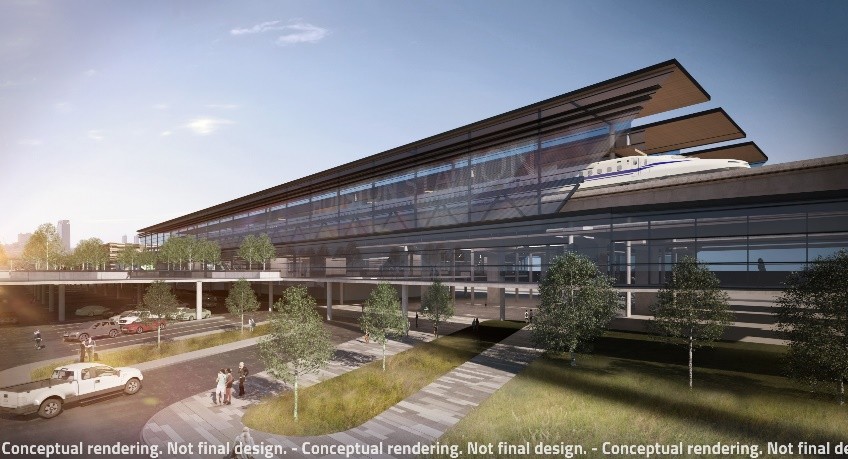
Conceptual image of the Houston station of the Texas high-speed rail
In terms of high-speed rail development, the U.S. construction route has distinctive characteristics: concept first, independent construction of sections, and surveying while designing. But in fact, these characteristics tend to lead to project control loss. If California's high-speed rail could follow a prudent feasibility study first, determine the design plan through complete surveying, and allocate sufficient funding for the main line, most of the unexpected events could have been avoided.
Indeed, even if the surveying is done first to determine the design plan, in the U.S., where land conflicts are not severe, land disputes caused by construction could be significantly reduced. During the construction of the initial segment of California's high-speed rail, phenomena such as the railway track deviating from the initial published position by dozens of meters and the actual area occupied differing greatly from the design were frequent.
Aside from correcting the development route, the U.S. also needs to clarify the national vision and conduct top-level design. China has already formed a set of high-speed rail construction standards covering planning, surveying, rolling stock, design, construction, acceptance, and operation, with at least hundreds of types.
Compared to this, the U.S. not only lacks national standards and standards in the high-speed rail field, but even has few standards for regular railways. Therefore, each railway is unique, which means that U.S. railways cannot achieve large-scale construction, successful experiences cannot be replicated, and costs cannot be low.
The reason for this phenomenon is that the U.S. federal government does not yet recognize the value of high-speed rail and railways. The U.S. is called the "country on wheels," with developed highways, and an average of 0.85 cars per person. At the same time, the U.S. air transport is also competitive, and tickets are not expensive.
The U.S. Department of Transportation believes that the total cost of California's high-speed rail will reach $135 billion, enough to buy 200 round-trip tickets for every resident of Los Angeles and San Francisco. Given such a high fixed investment, the money saved per trip seems insignificant, so it is not necessary to continue building the California high-speed rail.
From the current situation, the U.S. Department of Transportation's judgment makes sense. However, both California and Texas want to build high-speed rail, and some states want to jointly build inter-state high-speed rail, representing a part of real public opinion and practical needs. Therefore, the U.S. federal government should carefully consider the role of high-speed rail and railways. If it decides to develop high-speed rail, it cannot completely shift the responsibility of organizing the industrial chain to local railway companies. If there is no such planning, it should limit the initiation or allow market-oriented operations.
Except for the top-level strategic arrangement, the tactical execution of U.S. high-speed rail also has serious defects.
In 2018, California's high-speed rail employed 190 employees and 485 consultants. This large professional team was helpless in the face of real technical challenges, and its core ability was to suggest the management side to conduct various special investigations, euphemistically calling it to avoid problems encountered in high-speed rail construction in China, Japan, Spain, and other countries. The number of practical promoters decreased, and the number of dreamers increased, making the high-speed rail project difficult to move forward.
A long-standing problem in U.S. infrastructure is the high labor costs, but in addition to high wage expenditures, the U.S. railway has another common problem: a lack of experienced workers. At high wages, it takes several, tens, or even dozens of times longer to complete work, which is the deeper issue.
At the current stage of deep de-industrialization in the U.S., local railway construction workers previously had no fixed labor organizations and no experience in similar projects. Even for common engineering problems, they still need to first discuss, then train and test, and finally construct, resulting in extremely low efficiency.
Take a viaduct that is not very high, has a small main span, and does not require high technical requirements as an example, the main span construction began in July 2019, but it was not completed until February 2021. If such an engineering project were in China, even if assigned to a construction team with weaker technical capabilities, working only 6 hours a day, it would certainly be completed before 2020.
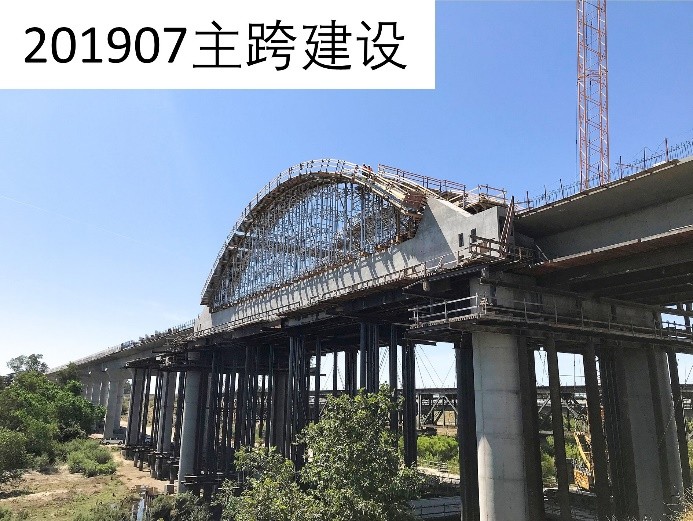

Before and after comparison of the viaduct
In fact, the best solution for promoting high-speed rail projects in the U.S. is to fully introduce international construction teams and foreign workers. This approach is the best choice in terms of schedule control and cost optimization. Now, building it with American workers does not equal "domestic" and "self-reliance." California's high-speed rail has Spanish teams openly involved, and Texas' high-speed rail is reportedly to collaborate with Japanese companies.
Because of various serious problems in the U.S. in top-level deployment, middle-level promotion, and specific implementation, in 2023, Scientific American proposed dozens of specific questions explaining "why the U.S. currently doesn't have high-speed rail," and some media pessimistically believe that a nationwide high-speed rail network in the U.S. may never be built. I think they are overly pessimistic about the U.S.'s technological potential, but underestimate the stubborn pride of Americans.
The biggest obstacle to the U.S. and its high-speed rail is precisely that arrogant mentality of "although I am a new player, no one knows me better."

This article is exclusive to Observer Net. The content of the article is purely the author's personal opinion and does not represent the platform's views. Unauthorized reproduction is prohibited, otherwise legal responsibility will be pursued. Follow Observer Net WeChat guanchacn to read interesting articles daily.
Original: https://www.toutiao.com/article/7529408356399645230/
Statement: This article represents the personal views of the author. Please express your attitude by clicking the [Top/Down] buttons below.